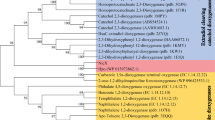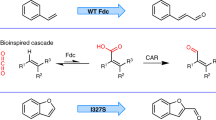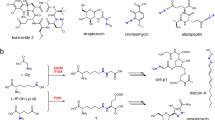Abstract
In chemical synthesis, the widely used Birch reduction of aromatic compounds to cyclic dienes requires alkali metals in ammonia as extremely low-potential electron donors. An analogous reaction is catalyzed by benzoyl–coenzyme A reductases (BCRs) that have a key role in the globally important bacterial degradation of aromatic compounds at anoxic sites. Because of the lack of structural information, the catalytic mechanism of enzymatic benzene ring reduction remained obscure. Here, we present the structural characterization of a dearomatizing BCR containing an unprecedented tungsten cofactor that transfers electrons to the benzene ring in an aprotic cavity. Substrate binding induces proton transfer from the bulk solvent to the active site by expelling a Zn2+ that is crucial for active site encapsulation. Our results shed light on the structural basis of an electron transfer process at the negative redox potential limit in biology. They open the door for biological or biomimetic alternatives to a basic chemical synthetic tool.
This is a preview of subscription content, access via your institution
Access options
Subscribe to this journal
Receive 12 print issues and online access
$259.00 per year
only $21.58 per issue
Buy this article
- Purchase on Springer Link
- Instant access to full article PDF
Prices may be subject to local taxes which are calculated during checkout





Similar content being viewed by others
Change history
07 July 2015
In the version of this article initially published online, the final intermediate in Figure 1a was originally depicted as a fully delocalized radical anion, which was incorrect. The error has been corrected for the print, PDF and HTML versions of this article.
21 July 2015
In the version of this article initially published, the PDB code for the structure of BamBC as isolated was listed as 4Z4O, which was incorrect. The correct code is 4Z40. The error has been corrected for the PDF and HTML versions of this article.
References
Birch, A.J. Reduction by dissolving metals I. J. Chem. Soc. 66, 430–436 (1944).
Birch, A.J. The Birch reduction in organic synthesis. Pure Appl. Chem. 68, 553–556 (1996).
Zimmerman, H.E. A mechanistic analysis of the Birch reduction. Acc. Chem. Res. 45, 164–170 (2012).
Zimmerman, H.E. & Wang, P.A. The regioselectivity of the Birch reduction. J. Am. Chem. Soc. 115, 2205–2216 (1993).
Koch, J., Eisenreich, W., Bacher, A. & Fuchs, G. Products of enzymatic reduction of benzoyl-CoA, a key reaction in anaerobic aromatic metabolism. Eur. J. Biochem. 211, 649–661 (1993).
Joshi, D.K., Sutton, J.W., Carver, S. & Blanchard, J.-P. Experiences with commercial production scale operation of dissolving metal reduction using lithium metal and liquid ammonia. Org. Process Res. Dev. 9, 997–1002 (2005).
Nandi, P., Dye, J.L. & Jackson, J.E. Birch reductions at room temperature with alkali metals in silica gel (Na2K-SG(I)). J. Org. Chem. 74, 5790–5792 (2009).
Boll, M., Löffler, C., Morris, B.E. & Kung, J.W. Anaerobic degradation of homocyclic aromatic compounds via arylcarboxyl-coenzyme A esters: organisms, strategies and key enzymes. Environ. Microbiol. 16, 612–627 (2014).
Kung, J.W. et al. Reversible biological Birch reduction at an extremely low redox potential. J. Am. Chem. Soc. 132, 9850–9856 (2010).
Buckel, W., Kung, J.W. & Boll, M. The benzoyl-coenzyme a reductase and 2-hydroxyacyl-coenzyme a dehydratase radical enzyme family. ChemBioChem 15, 2188–2194 (2014).
Fuchs, G., Boll, M. & Heider, J. Microbial degradation of aromatic compounds—from one strategy to four. Nat. Rev. Microbiol. 9, 803–816 (2011).
Boll, M. & Fuchs, G. Benzoyl-coenzyme A reductase (dearomatizing), a key enzyme of anaerobic aromatic metabolism. ATP dependence of the reaction, purification and some properties of the enzyme from Thauera aromatica strain K172. Eur. J. Biochem. 234, 921–933 (1995).
Unciuleac, M. & Boll, M. Mechanism of ATP-driven electron transfer catalyzed by the benzene ring-reducing enzyme benzoyl-CoA reductase. Proc. Natl. Acad. Sci. USA 98, 13619–13624 (2001).
Löffler, C. et al. Occurrence, genes and expression of the W/Se-containing class II benzoyl-coenzyme A reductases in anaerobic bacteria. Environ. Microbiol. 13, 696–709 (2011).
Kung, J.W. et al. Identification and characterization of the tungsten-containing class of benzoyl-coenzyme A reductases. Proc. Natl. Acad. Sci. USA 106, 17687–17692 (2009).
Chan, M.K., Mukund, S., Kletzin, A., Adams, M.W. & Rees, D.C. Structure of a hyperthermophilic tungstopterin enzyme, aldehyde ferredoxin oxidoreductase. Science 267, 1463–1469 (1995).
Wischgoll, S. et al. Gene clusters involved in anaerobic benzoate degradation of Geobacter metallireducens. Mol. Microbiol. 58, 1238–1252 (2005).
Hille, R. The molybdenum oxotransferases and related enzymes. Dalton Trans. 42, 3029–3042 (2013).
Pushie, M.J., Cotelesage, J.J. & George, G.N. Molybdenum and tungsten oxygen transferases—structural and functional diversity within a common active site motif. Metallomics 6, 15–24 (2014).
Messerschmidt, A. et al. Crystal structure of pyrogallol-phloroglucinol transhydroxylase, an Mo enzyme capable of intermolecular hydroxyl transfer between phenols. Proc. Natl. Acad. Sci. USA 101, 11571–11576 (2004).
Moser, C.C., Keske, J.M., Warncke, K., Farid, R.S. & Dutton, P.L. Nature of biological electron transfer. Nature 355, 796–802 (1992).
Cotelesage, J.J., Pushie, M.J., Grochulski, P., Pickering, I.J. & George, G.N. Metalloprotein active site structure determination: synergy between X-ray absorption spectroscopy and X-ray crystallography. J. Inorg. Biochem. 115, 127–137 (2012).
Pandelia, M.E., Ogata, H. & Lubitz, W. Intermediates in the catalytic cycle of [NiFe] hydrogenase: functional spectroscopy of the active site. ChemPhysChem 11, 1127–1140 (2010).
Romão, M.J. Molybdenum and tungsten enzymes: a crystallographic and mechanistic overview. Dalton Trans. 21, 4053–4068 (2009).
Hu, Y., Faham, S., Roy, R., Adams, M.W. & Rees, D.C. Formaldehyde ferredoxin oxidoreductase from Pyrococcus furiosus: the 1.85 Å resolution crystal structure and its mechanistic implications. J. Mol. Biol. 286, 899–914 (1999).
Seiffert, G.B. et al. Structure of the non-redox-active tungsten/[4Fe:4S] enzyme acetylene hydratase. Proc. Natl. Acad. Sci. USA 104, 3073–3077 (2007).
Weinberg, D.R. et al. Proton-coupled electron transfer. Chem. Rev. 112, 4016–4093 (2012).
Outten, C.E. & O'Halloran, T.V. Femtomolar sensitivity of metalloregulatory proteins controlling zinc homeostasis. Science 292, 2488–2492 (2001).
Thiele, B. et al. Aromatizing cyclohexa-1,5-diene-1-carbonyl-coenzyme A oxidase: characterization and its role in anaerobic aromatic metabolism. J. Biol. Chem. 283, 20713–20721 (2008).
Smith, D.M., Golding, B.T. & Radom, L. Facilitation of enzyme-catalyzed reactions by partial proton transfer: application to coenzyme-B12–dependent methylmalonyl-CoA mutase. J. Am. Chem. Soc. 121, 1383–1384 (1999).
Möbitz, H. & Boll, M. A Birch-like mechanism in enzymatic benzoyl-CoA reduction: a kinetic study of substrate analogues combined with an ab initio model. Biochemistry 41, 1752–1758 (2002).
Kim, J., Darley, D.J., Buckel, W. & Pierik, A.J. An allylic ketyl radical intermediate in clostridial amino-acid fermentation. Nature 452, 239–242 (2008).
Gross, G.G. & Zenk, M.H. Darstellung und Eigenschaften von Coenzym A-Thioestern substituierter Zimtsäuren. Z. Naturforschung 21b, 683–690 (1966).
Kabsch, W. Xds. Acta Crystallogr. D Biol. Crystallogr. 66, 125–132 (2010).
McCoy, A.J., Grosse-Kunstleve, R.W., Storoni, L.C. & Read, R.J. Likelihood-enhanced fast translation functions. Acta Crystallogr. D Biol. Crystallogr. 61, 458–464 (2005).
McCoy, A.J., Storoni, L.C. & Read, R.J. Simple algorithm for a maximum-likelihood SAD function. Acta Crystallogr. D Biol. Crystallogr. 60, 1220–1228 (2004).
Afonine, P.V. et al. phenix.model_vs_data: a high-level tool for the calculation of crystallographic model and data statistics. J. Appl. Crystallogr. 43, 669–676 (2010).
Emsley, P. & Cowtan, K. Coot: model-building tools for molecular graphics. Acta Crystallogr. D Biol. Crystallogr. 60, 2126–2132 (2004).
Murshudov, G.N., Vagin, A.A. & Dodson, E.J. Refinement of macromolecular structures by the maximum-likelihood method. Acta Crystallogr. D Biol. Crystallogr. 53, 240–255 (1997).
Rehr, J.J., Mustre de Leon, J., Zabinsky, S.I. & Albers, R.C. Theoretical x-ray absorption fine structure standards. J. Am. Chem. Soc. 113, 5135–5140 (1991).
Mustre de Leon, J., Rehr, J.J., Zabinsky, S.I. & Albers, R.C. Ab initio curved-wave x-ray-absorption fine structure. Phys. Rev. B Condens. Matter 44, 4146–4156 (1991).
Glasoe, P.K. & Long, F.A. Use of glass electrodes to measure acidities in deuterium oxide. J. Phys. Chem. 64, 188–190 (1960).
Sano, A., Takazawa, M. & Takitani, S. High performance liquid chromatography determination of cyanide in urine by pre-column fluorescence derivatization. Biomed. Chromatogr. 3, 209–212 (1989).
Tracqui, A., Raul, J.S., Géraut, A., Berthelon, L. & Ludes, B. Determination of blood cyanide by HPLC-MS. J. Anal. Toxicol. 26, 144–148 (2002).
Driesener, R.C. et al. [FeFe]-hydrogenase cyanide ligands derived from S-adenosylmethionine-dependent cleavage of tyrosine. Angew. Chem. Int. Edn Engl. 49, 1687–1690 (2010).
Acknowledgements
This work was funded by the German Research Foundation (DFG) in the SPP1319 (BO 1565/10-2 and ER 222/5), by the European Cooperation in Science and Technology Action CM1201 and the Swiss National Foundation for Scientific Research (SNF) (Doc.Mobility grant nos. P1SKP3-148452 and P1SKP3-155073). Work at the University of Saskatchewan was supported by the Canadian Research Chairs Program (G.N.G.), the Natural Sciences and Engineering Research Council of Canada and the Canadian Institutes of Health Research. J.J.H.C. is a CIHR-Training grant in Health Research Using Synchrotron Techniques (THRUST) Associate. The Stanford Synchrotron Radiation Lightsource is supported by the US Department of Energy and the National Institutes of Health. Work at the Helmholtz Center for Environmental Research, Leipzig, Germany (Department of Analytical Chemistry), was funded by the German Federal Ministry of Education and Research. Work at the University of Strasbourg was supported by the Centre International de Recherche aux Frontières de la Chimie (RFC) and the Centre National des Recherches Scientifiques (CNRS). We thank H. Michel for continuous support and the staff of beamline PXII at the Swiss Light Source for help during data collection.
Author information
Authors and Affiliations
Contributions
T.W. crystallized the enzyme collected, processed and refined X-ray data, and prepared figures; S.G.H. purified and characterized the enzyme, performed kinetic assays, prepared samples for spectroscopic analyses (EPR, FT-IR, EXAFS and ICP-MS) and carried out CN analyses and EPR measurements; S. Weidenweber processed and refined X-ray data; J.W.K. purified and characterized the enzyme, performed kinetic assays, and prepared samples for ICP-MS analyses; J.J.H.C. and G.N.G. collected and modeled EXAFS data; H.-J.S. conducted ICP-MS analyses; P.H. performed and interpreted FT-IR analyses; T.B. and S. Weber conducted and interpreted EPR measurements; U.E. and M.B. designed the study, analyzed data and wrote the paper. All authors discussed the results and commented on the manuscript.
Corresponding authors
Ethics declarations
Competing interests
The authors declare no competing financial interests.
Supplementary information
Supplementary Text and Figures
Supplementary Results, Supplementary Figures 1–8 and Supplementary Tables 1–4 (PDF 1018 kb)
Rights and permissions
About this article
Cite this article
Weinert, T., Huwiler, S., Kung, J. et al. Structural basis of enzymatic benzene ring reduction. Nat Chem Biol 11, 586–591 (2015). https://doi.org/10.1038/nchembio.1849
Received:
Accepted:
Published:
Issue Date:
DOI: https://doi.org/10.1038/nchembio.1849
This article is cited by
-
An unusual strategy for the anoxic biodegradation of phthalate
The ISME Journal (2017)
-
The active site structure and catalytic mechanism of arsenite oxidase
Scientific Reports (2017)



